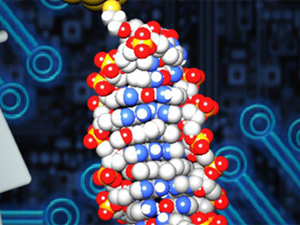



Date:09/04/16
 A team of researchers from the University of Georgia and Ben-Gurion University has developed an electronic component so tiny, you can't even see it under an ordinary microscope. See, the team used a single DNA molecule to create a diode, a component that conducts electricity mostly in one direction. Further, the DNA molecule they designed for the study only has 11 base pairs. That makes it a pretty short helix, considering a human genome has approximately 3 billion pairs.
A team of researchers from the University of Georgia and Ben-Gurion University has developed an electronic component so tiny, you can't even see it under an ordinary microscope. See, the team used a single DNA molecule to create a diode, a component that conducts electricity mostly in one direction. Further, the DNA molecule they designed for the study only has 11 base pairs. That makes it a pretty short helix, considering a human genome has approximately 3 billion pairs.
To allow a current to flow through the DNA, the team inserted a molecule called "coralyne" into the helix. What the team came up with was a diode, because the current was 15 times stronger for negative voltages than for positive. The study's lead author Bingqian Xu decided to experiment on DNA to create minuscule components, since we can't exactly use silicon for parts that size.
He said: "For 50 years, we have been able to place more and more computing power onto smaller and smaller chips, but we are now pushing the physical limits of silicon. If silicon-based chips become much smaller, their performance will become unstable and unpredictable."
Xu's and his team's efforts could eventually lead to more nanoscale electronics. Plus, the project could lead to more advanced devices, since scaling down components means engineers can cram more into regular-sized gadgets.
Researchers made the smallest diode using a DNA molecule
 A team of researchers from the University of Georgia and Ben-Gurion University has developed an electronic component so tiny, you can't even see it under an ordinary microscope. See, the team used a single DNA molecule to create a diode, a component that conducts electricity mostly in one direction. Further, the DNA molecule they designed for the study only has 11 base pairs. That makes it a pretty short helix, considering a human genome has approximately 3 billion pairs.
A team of researchers from the University of Georgia and Ben-Gurion University has developed an electronic component so tiny, you can't even see it under an ordinary microscope. See, the team used a single DNA molecule to create a diode, a component that conducts electricity mostly in one direction. Further, the DNA molecule they designed for the study only has 11 base pairs. That makes it a pretty short helix, considering a human genome has approximately 3 billion pairs.To allow a current to flow through the DNA, the team inserted a molecule called "coralyne" into the helix. What the team came up with was a diode, because the current was 15 times stronger for negative voltages than for positive. The study's lead author Bingqian Xu decided to experiment on DNA to create minuscule components, since we can't exactly use silicon for parts that size.
He said: "For 50 years, we have been able to place more and more computing power onto smaller and smaller chips, but we are now pushing the physical limits of silicon. If silicon-based chips become much smaller, their performance will become unstable and unpredictable."
Xu's and his team's efforts could eventually lead to more nanoscale electronics. Plus, the project could lead to more advanced devices, since scaling down components means engineers can cram more into regular-sized gadgets.
Views: 481
©ictnews.az. All rights reserved.Similar news
- Azerbaijani project to monitor disease via mobile phones
- Innovative educational system to be improved under presidential decree
- NTRC prolongs license of two TV and radio organizations for 6 years
- Azerbaijan establishes e-registry for medicines
- Azerbaijani museum introduces e-guide
- Nar Mobile opens “Nar Dunyasi” sales and service center in Siyazan city
- International conference on custom electronic services held in Baku
- OIC secretary general to attend COMSTECH meeting in Baku
- Azerbaijan develops earthquake warning system
- New law to regulate transition to digital broadcasting in Azerbaijan
- Azerbaijani State Social Protection Fund introduces electronic digital signature
- Intellectual traffic management system in Baku to be commissioned in December
- Tax Ministry of Azerbaijan started receiving video-addresses
- World Bank recommends Azerbaijan to speed up e-service introduction in real estate
- Azerbaijan to shift to electronic registration of real estate





















